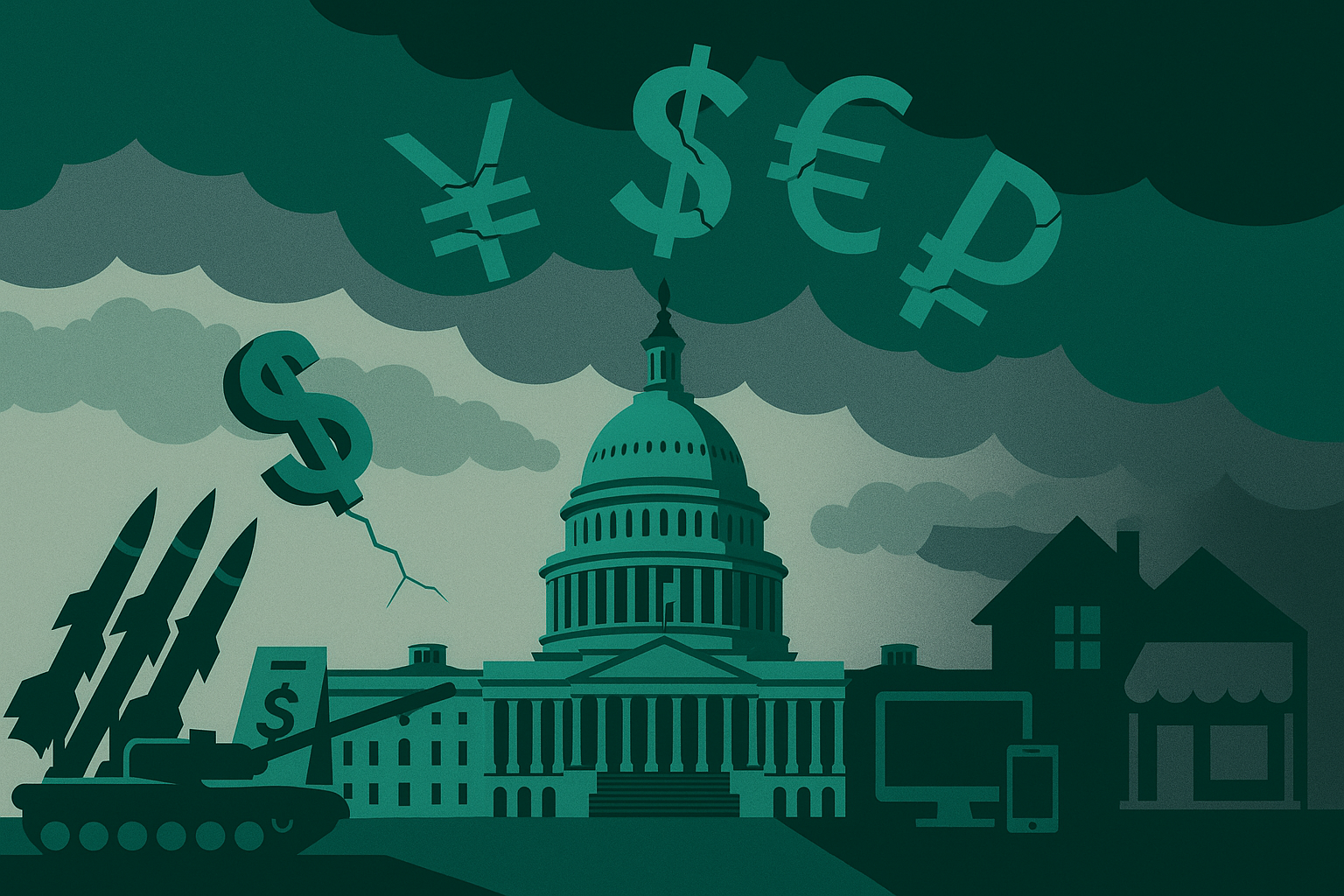July 2025 Economic Risk Analysis
By a Senior Economist
- 🧭 Executive Summary
- 1. 📊 Fiscal Overextension and Debt Spiral
- 2. 🔥 Military Keynesianism: Short-Term Gain, Long-Term Pain
- 3. 🌍 Global Currency Confidence and De-dollarization
- 4. 🧨 Inflation Persistence and the Return of Stagflation
- 5. 📉 Early Recession Indicators
- 6. 🧠 Strategic Outlook: Three Potential Scenarios
- ✅ Conclusion
- 🔖 Recommended Policy Actions
🧭 Executive Summary
As the United States deepens its military commitments in Ukraine, the Middle East, and potentially East Asia, the specter of a domestic economic downturn looms larger. While defense spending may offer short-term industrial stimulus, the prolonged nature of these conflicts poses significant threats to the fiscal balance, inflation dynamics, labor market stability, and ultimately, consumer confidence. This report evaluates how sustained warfare could tip the U.S. economy into a new era of stagflationary recession.
1. 📊 Fiscal Overextension and Debt Spiral
1.1 Exploding Defense Budget
The recent $1.7 trillion military aid and deterrence package—encompassing Ukraine, Israel, and Taiwan—marks one of the most aggressive fiscal interventions since World War II. Combined with existing entitlements and infrastructure outlays, federal spending is now projected to surpass 25% of GDP by Q4 2025.
1.2 Unsustainable Debt Dynamics
Public debt-to-GDP has breached the 130% threshold. According to the Congressional Budget Office (CBO), interest payments alone will exceed military spending by 2027 if current trends persist—raising alarm across global bond markets.
2. 🔥 Military Keynesianism: Short-Term Gain, Long-Term Pain
2.1 Crowding Out Civilian Investment
Rising Treasury yields—now over 5.5% on 10-year notes—have already dampened real estate development, venture capital funding, and small business lending. The classic “guns vs. butter” dilemma is playing out in real time.
2.2 Dislocation in Labor Markets
While defense manufacturing hubs in states like Texas and Virginia are booming, civilian tech, hospitality, and retail sectors are shedding jobs. This bifurcation risks deepening inequality and regional economic divergence.
3. 🌍 Global Currency Confidence and De-dollarization
3.1 The Weaponization of the Dollar
America’s increased reliance on sanctions and military-linked SWIFT restrictions is accelerating calls for alternative systems (e.g., BRICS currency, digital yuan). As reserve diversification grows, downward pressure on the U.S. dollar intensifies.
3.2 International Risk Premium on U.S. Treasuries
Foreign central banks—especially in Asia and the Middle East—have slowed their purchases of Treasuries. The U.S. may soon need to finance its deficits domestically, risking even sharper yield spikes.
4. 🧨 Inflation Persistence and the Return of Stagflation
4.1 Energy and Commodity Shocks
Conflict-driven supply disruptions in oil, gas, rare earths, and grains are creating second-round inflation effects. Core PCE inflation remains stuck at 4.2%—well above the Fed’s 2% target.
4.2 Monetary Policy Constraints
The Federal Reserve faces a paradox: further tightening would suppress demand and risk a credit crisis, yet loosening could ignite inflation. This impasse risks a policy paralysis akin to the 1970s.
5. 📉 Early Recession Indicators
| Metric | Status (July 2025) |
|---|---|
| Consumer Sentiment Index | Lowest since March 2020 |
| Residential Housing Starts | -8.3% YoY |
| Non-Defense Capital Goods Orders | Flatlining |
| Corporate Defaults (YTD) | +19% YoY (notably in tech & retail) |
| Job Openings (non-defense) | Down for 4 consecutive months |
6. 🧠 Strategic Outlook: Three Potential Scenarios
| Scenario | Description | Probability | Outcome |
|---|---|---|---|
| 🎯 Strategic Recalibration | U.S. scales back foreign entanglements, refocuses on domestic resilience | 30% | Soft landing |
| ⚔️ Two-Front Engagement | Prolonged involvement in Europe and Asia with no exit roadmap | 50% | Inflation + Recession |
| 💣 Escalation Spiral | New conflict fronts (e.g. Iran, Taiwan), debt crisis erupts | 20% | Deep recession, stagflation |
✅ Conclusion
The United States stands at an economic inflection point. Without a strategic pivot away from prolonged, expensive conflicts—and a return to domestic investment and fiscal prudence—the risk of a 1970s-style stagflationary recession becomes not just plausible, but probable. The key to averting this fate lies not only in central bank precision, but in coherent geopolitical restraint and a bipartisan fiscal strategy.
🔖 Recommended Policy Actions
- Enact a Sunset Clause on all foreign military aid packages to cap fiscal exposure.
- Launch a Domestic Resilience Investment Plan focusing on energy, AI, and infrastructure.
- Convene a Strategic Reserve Currency Forum with allies to preempt de-dollarization risks.
- Introduce War Powers Budgetary Act to limit executive military expenditures without Congressional oversight.


